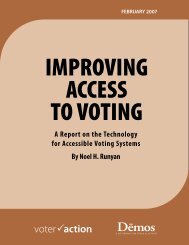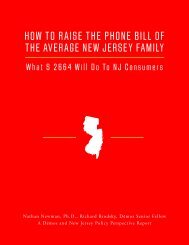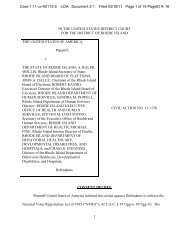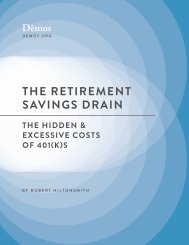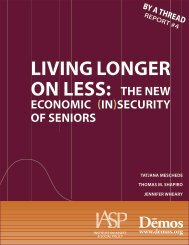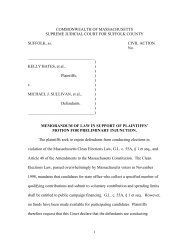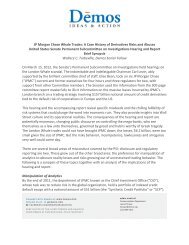Philip Harvey - Demos
Philip Harvey - Demos
Philip Harvey - Demos
Create successful ePaper yourself
Turn your PDF publications into a flip-book with our unique Google optimized e-Paper software.
PHILIP HARVEY<br />
RATIONALE<br />
POLICY BRIEF<br />
BACK TO WORK A P U B L I C J O B S<br />
PROPOSAL FOR ECONOMIC RECOVERY<br />
Today there are almost 29 million people in the United States for whom the economy has failed to<br />
perform its most important function: providing enough jobs to go around. is reality is dimming the<br />
lights on the American Dream. It threatens to steal from an entire generation the dignity that comes<br />
from a hard day’s work. Our political leaders have eectively accepted this situation, turning from the<br />
moderate job creation strategies of 2009-2010 to an austerity agenda that will cost as many as 1 million<br />
more jobs. 1<br />
Meanwhile, the corporate sector has largely recovered from the recession—with prots at an all-time<br />
record of $1.659 trillion in the third quarter of 2010. 2 e private sector is currently cash-rich, yet all<br />
indications are that businesses are still reluctant to begin hiring or investing in major capital improvements.<br />
Nearly a year and half past the ocial end of the Great Recession, it’s clear that the private sector is not<br />
going to provide jobs for everyone who needs them and wants to work.<br />
e scale of the jobs crisis is large: Almost 14 million active job seekers remain unemployed. Another<br />
6.6 million people who are not actively looking for work (and therefore are not counted as unemployed)<br />
say they want jobs. Among workers who are lucky enough to have jobs, 8.4 million are employed parttime<br />
but want full-time jobs. e jobless are not a perfect mirror of our society—the toll is much greater<br />
among less educated workers and communities of color.<br />
In order to return unemployment to 4.5 percent and restore consumer demand, approximately 8.2<br />
million additional jobs must be created. At the pace of current job creation, it would take at least 20<br />
years to reach full employment. 3 e toll joblessness has had already on communities and families has<br />
been severe. We can no longer aord to wait idly for recovery to happen. Instead, we must fuel a recovery<br />
by putting America back to work.<br />
Our direct public jobs proposal is conceptually simple: the public sector can directly create jobs quickly,<br />
serve vital community needs and target those hurt most in this economy. e benets are multiple.<br />
Americans without jobs get meaningful work until a true recovery takes place, and communities get<br />
urgent and long-ignored needs met. Our nation ensures that the talents and skills of our workers do not<br />
atrophy, and our families and communities recover from the deepest recession since the Great Depression.<br />
MEDIA INQUIRIES: TIM RUSCH | COMMUNICATIONS DIRECTOR | TRUSCH@DEMOS.ORG | 212-389-1407
THE ADVANTAGES OF DIRECT PUBLIC JOBS<br />
It’s Cost-Eective<br />
A comparison of three dierent stimulus approaches illustrates the power of the direct<br />
job-creation strategy. e two stimulus methods most recently enacted were tax cuts and<br />
extended benets programs like unemployment insurance and food stamps. $100 billion<br />
spent on tax cuts would indirectly generate 136,000 full time jobs within two years,<br />
while $100 billion spent on benets would indirectly generate 714,000.<br />
NUMBER OF FULL-TIME JOBS CREATED<br />
JOB CREATION EFFECT OF A TWO YEAR<br />
$100 BILLION FISCAL STIMULUS<br />
4000000<br />
3500000<br />
3000000<br />
2500000<br />
2000000<br />
1500000<br />
2 Back to Work: A Public Jobs Proposal for Economic Recovery<br />
e third option -- $100<br />
billion spent to directly hire<br />
Americans workers – would<br />
create 2.6 million fulltime<br />
jobs over two years:<br />
2.1 million directly and<br />
an additional half million<br />
indirectly.<br />
It is important to note that the<br />
failure to provide jobs for people<br />
who want them isn’t cheap<br />
either. e Great Recession<br />
was responsible for nearly twothirds<br />
of the 2009 decit. 4<br />
Accordingly, aggressive action<br />
to lower unemployment will<br />
be the most eective, fair and<br />
sustainable way to close the<br />
decit: for every million unemployed Americans who goes back to work, the decit falls by<br />
$54 billion. 5<br />
1000000<br />
500000<br />
0<br />
TWO YEARS<br />
FOUR YEARS<br />
YEARS OF STIMULUS<br />
BUSH TAX CUTS<br />
UI AND SNAP BENEFITS<br />
DIRECT JOBS PROPOSAL<br />
2. It Puts Americans Back to Work Now<br />
Public jobs have “time value” because they are jobs created immediately. Tax cuts,<br />
benets payments and other indirect stimulus approaches do not start “working” on job<br />
creation immediately; they require the recipients to spend the money at their discretion,<br />
which eventually aggregates to increase overall demand in the economy. is in turn<br />
results in businesses hiring workers in order to meet the increased demand. Economists<br />
often use the term “time value” with regards to money to explain why people are willing<br />
to pay interest to borrow it. e time value of money is nothing compared to the time<br />
value of jobs during a recession. Measured in the currency of human well-being, every<br />
job created for an unemployed worker during a recessionary contraction is worth far<br />
more than the same job created two years later. By then, a house may have been lost. A<br />
marriage may have failed. A child may have been traumatized in ways that will resonate<br />
throughout his or her life.
3. It’s Targeted to ose Who Need Jobs Most<br />
e undeserved pain of this economic crisis has not been felt evenly. While the jobless<br />
rate in our nation’s capital was 9.6 percent in December 2010, it was twice as high in<br />
Hancock County, Georgia and three times as high in Imperial County, California. 6<br />
Young workers, workers without a college degree and workers of color at all education<br />
levels are considerably more likely to be unemployed than the average American. 7<br />
Unemployment in the nancial industry is only 7.5 percent, but is over 22 percent in<br />
construction. 8 ere are roughly four million “99ers” collecting whose job search has<br />
outlasted their unemployment insurance 9 —which doesn’t even capture the at least 56<br />
percent of workers who don’t qualify for unemployment. 10<br />
Indirect stimulus measures such as tax cuts and benets payments do not guarantee that<br />
the jobs will be created in the communities, sectors and populations hardest-hit by the<br />
recession. e strategy can be designed to target these job-seekers, reducing inequality<br />
and blunting the most extreme suering felt in our nation.<br />
Eligibility requirements could consider the length of time a person has been<br />
unemployed and their nancial need for work, to ensure that those who are hurt most<br />
by private sector job losses are the rst to benet from the program. e program could<br />
also be designed to recruit workers with skills from sectors with high job losses, such as<br />
construction and manufacturing.<br />
4. It Meets Vital National and Community Needs<br />
e proposal is designed to create jobs that ll unmet needs in the job-seekers’ own<br />
communities. ese unmet needs include weaknesses in our human and physical<br />
infrastructure. For example, U.S. ranks 27th—nearly last—among developed countries<br />
when it comes to investments in education, health care and other vital social needs 11 ,<br />
and 46 states have recently cut back on social services funding due to budget shortfalls. 12<br />
Putting Americans directly to work in areas such as health care, child care, education,<br />
recreation, elder care, and cultural enrichment could expand and improve the quality of<br />
these vital public services.<br />
Our physical infrastructure is also unworthy of our nation. One out of every three U.S.<br />
roads is in poor or mediocre condition. 13 At least 26,000 schools are in need of major<br />
repairs. 14 Direct public job creation would help rebuild America’s infrastructure -- an<br />
economic investment in and of itself -- with improvements to schools, roads, bridges,<br />
and energy eciency in buildings and homes nationwide.<br />
e possibilities are well-illustrated by the accomplishments of the Civil Works<br />
Administration (CWA), an emergency job creation program that operated for about<br />
four months over the winter of 1933-34 in the United States. Established by President<br />
Roosevelt in early November, 1933, the CWA went from a mere proposal to a fully<br />
operational program with over 4 million employees in less than two months.<br />
Despite its hurried implementation, the program’s achievements are truly astounding.<br />
In Chicago, over 11 thousand CWA workers laid brick pavements in a major streetimprovement<br />
project. Approximately 60,000 public buildings were repaired or<br />
<strong>Philip</strong> <strong>Harvey</strong> 3
constructed, two thirds of them schools. Almost 2300 miles of sewer lines were laid or<br />
repaired. Swamp-drainage projects to ght malaria employed 30,000 CWA workers, and<br />
17,000 unemployed coal miners were employed sealing abandoned coal mines to protect<br />
ground-water supplies. Over 3700 playgrounds and 200 public swimming pools were<br />
constructed along with countless comfort stations, park benches and water fountains.<br />
e CWA’s white collar projects included education projects within existing schools<br />
that provided jobs for 50,000 laid-o teachers. Another 13,000 kept small rural schools<br />
open through the winter when normally they would have closed. irty-three thousand<br />
teachers were employed in adult education classes and in program-operated pre-schools.<br />
e adult classes served 800,000 learners and the pre-schools were attended by 60,700<br />
children.<br />
WHAT WOULD A DIRECT PUBLIC JOB STRATEGY LOOK LIKE?<br />
Direct job creation isn’t a new idea to the United States. A direct jobs program was rst<br />
enacted by President Roosevelt in late 1933 to counter the record unemployment levels<br />
of the Great Depression, prime the pump of business and tame growing political unrest.<br />
A modern direct job-creation program faces new challenges, but could include the<br />
following characteristics:<br />
Direct Administration. A variety of administrative structures are possible and<br />
mutually compatible, but projects would generally be undertaken by the federal<br />
government and agencies in partnership with local governments. Precautions<br />
would be required to prevent local ocials from using the program to replace<br />
public employees with federally-funded program workers. Contracting with nonprot<br />
organizations would also be possible.<br />
Reasonable Pay and Benets. e jobs would ideally pay approximately the same<br />
wage that persons with similar qualications and experience earn in the regular<br />
labor market. It would also provide employer-provided health insurance, child care<br />
services, guaranteed paid sick leave, and access to the Earned Income Tax Credit<br />
and SNAP for low earners.<br />
HOW CAN WE AFFORD DIRECT JOB CREATION?<br />
A million jobs could be created for a total budget ed cost of $46.4 billion per year. e same<br />
$46.4 billion in program spending would also trigger a multiplier eect that would create<br />
an additional 414,000 jobs outside the program. e damage widespread unemployment<br />
is inicting on the federal budget demands the question: how can we aord to not put<br />
Americans back to work? In fact, because direct job creation would make more Americans<br />
taxpayers again, the net cost of the a $46.4 billion proposal would be $17.8 billion lower<br />
than the initial outlay.<br />
e cost to produce the 8.2 million jobs needed to put Americans back to work would<br />
be $235 billion. If the Bush-era tax cuts had been allowed to expire at the end of 2010,<br />
the federal government would have collected about $295 billion in additional revenue<br />
during 2011. is would have been more than enough to cover the cost of the jobs<br />
program. Moreover, using the Bush-era tax cut money in this way would also increase<br />
4 Back to Work: A Public Jobs Proposal for Economic Recovery
TABLE 3:<br />
ANNUAL COST OF CREATING 1 MILLION JOBS* IN A DIRECT JOB CREATION<br />
PROGRAM, PLUS AN ADDITIONAL 414,000 JOBS* OUTSIDE THE PROGRAM<br />
Direct Job Creation Program Costs<br />
Estimated Avg. Hourly Wage of UI Recipients Employed in Program $ 17.46 dollars<br />
Estimated Avg. Hourly Wage of Other Program Participants $ 11.70 dollars<br />
Annual Wage Bill $ 26.8 billion<br />
Employer’s share of FICA taxes $ 2.1 billion<br />
Cost of Providing Federal Employees Health Benets (FEHB) $ 5.9 billion<br />
Non-Labor Costs (space, materials, transportation, etc.) $ 11.6 billion<br />
Total Jobs Program Budget $ 46.4 billion<br />
Additional Govt. Revenue and Savings Attributable to Program<br />
Estimated Social Security & Income Taxes Receipts $ 5.4 billion<br />
Estimated UI Savings $ 6.1 billion<br />
Estimated Medicaid and CHIP Savings Due to FEHB Enrollments $ 1.6 billion<br />
Estimated Revenue from Goods & Services Produced<br />
@ avg. of 10¢/dollar $ 4.6 billion<br />
Total Additional Govt. Revenue and Savings $ 17.8 billion<br />
Net Cost of Job Creation Program $ 28.6 billion<br />
Indirect Job Creation Eect of Direct Job Creation Program 414,000 jobs<br />
Source: Author’s calculations using BLS and DOL data.<br />
* Approximately 85% of the jobs in the program (851,000) would be full-time positions. e other 15% (149,000) would be part-time. e<br />
jobs created indirectly outside the program probably would mirror the full- to part-time ratio for the labor force as a whole, approximately 81%<br />
of whose members normally work full time (more than 35 hours per week) and 19% of whom normally work part time.<br />
Assumptions<br />
is cost estimate assumes that jobs program participants could elect to work either full-time or part-time, that they would be oered jobs<br />
consistent with their skills and experience, and that they would be paid the same hourly wage that similarly qualied and experienced workers<br />
receive as new hires in comparable jobs in the regular public and private sector labor market (except that upper-level managers would receive the<br />
equivalent of public rather than private sector managerial salaries).<br />
e estimated average hourly wage of former UI recipients enrolled in the jobs program is based on their estimated prior earnings in covered employment.<br />
e average hourly wage for which other program participants would qualify (ocially unemployed individuals who are not receiving<br />
UI benets, involuntary part-time workers, and persons who want a job but are not actively looking for one) is assumed to equal that of persons<br />
employed part-time in existing jobs in the economy. e estimate assumes that all ocially unemployed workers would accept employment in<br />
the program if it were oered to them, but only 75 percent of involuntary part-time workers and 50 percent the group identied in Figure 1<br />
as discouraged workers. e program cost estimate assumes that the program workforce would be a cross section of these three groups of likely<br />
candidates.<br />
e estimate assumes that program participants would be liable for income, Medicare and FICA taxes on their wages, and that the government<br />
would pay the employer’s share of their FICA taxes as it does for other federal employees. e estimate also assumes that program participants<br />
would receive the same fringe benets, including health insurance, as other federal government employees.<br />
Finally, the program cost estimate assumes that 1 dollar would be spent on non-labor costs (supplies and materials) for every 3 dollars in labor<br />
costs. at was the average ratio of non-labor to labor costs in New Deal direct job creation programs, and it would allow for a reasonable mixture<br />
of public goods and services to be produced by the program today.<br />
e program’s indirect job creation eect has been estimated using a multiplier of 1.29 for expenditures on program wages, 9 1.5 for program<br />
expenditures on health insurance benets, 1.5 for purchases of supplies and capital goods for the program, and 0.0 for payments by the program<br />
of the employer’s share of Social Security and Medicare taxes. e composite multiplier eect of overall spending on the program based on these<br />
partial multiplier eects is estimated at 1.31. It is assumed that payroll employment outside the program would increase by one million jobs for<br />
every 1% increase in GDP caused by the multiplier eect of program spending.<br />
<strong>Philip</strong> <strong>Harvey</strong> 5
employment outside the program by an additional 3.1 million jobs. If those jobs became<br />
self-sustaining—as it is reasonable to hope they would—then during 2012, the jobs<br />
program would need to provide only 5.1 million jobs to keep the unemployment rate at<br />
4.5 percent at a net cost of $147 billion.<br />
CONCLUSION<br />
Every day that it drags on, the jobless recovery is violating core American values of<br />
hard work, family economic security and greater opportunity for the next generation.<br />
It doesn’t have to be this way. e near-record corporate prots, obscenely juxtaposed<br />
against near-record unemployment and wage inequality demonstrate that we simply<br />
can not wait for the private sector to put our fellow Americans back to work. A true<br />
American economic recovery must start with jobs. Direct public job-creation oers a<br />
pragmatic, cost-eective and morally urgent solution to the greatest problem of our<br />
time.<br />
<br />
6 Back to Work: A Public Jobs Proposal for Economic Recovery
ENDNOTES<br />
1. Rebecca eiss, “Republican proposal to “right our scal ship” throws more workers overboard” Economic<br />
Policy Institute, February 9, 2011, accessed on February 28, 2011 at http://www.epi.org/analysis_and_<br />
opinion/entry/6756/.<br />
2. Catherine Rampell, “Corporate Prots Were Highest on Record Last Quarter,” the New York Times,<br />
November 23, 2010, accessed on February 28, 2011 at http://www.nytimes.com/2010/11/24/business/<br />
economy/24econ.html?adxnnl=1&adxnnlx=1298664083-QpJm6uSGwDYama5cBIFotw.<br />
3. Heidi Shierholz “Job growth improves, but pace leaves full employment 20 years away,” Economic<br />
Policy Institute, November 5, 2011, accessed on February 28, 2011 at http://www.epi.org/publications/<br />
entry/job_growth_improves_but_pace_leaves_full_employment_20_years_away.<br />
4. Kathy A. Rung and James R. Horney, “Critics Still Wrong on What’s Driving Decits in Coming<br />
Years,” Center on Budget and Policy Priorities, June 28, 2010, accessed on February 28, 2011 at http://<br />
www.cbpp.org/les/12-16-09bud.pdf.<br />
5. Oce of Management and Budget, “e Budget for Fiscal Year 2009: Historical Tables” http://www.<br />
whitehouse.gov/sites/default/les/omb/budget/fy2009/pdf/hist.pdf.<br />
6. Bureau of Labor Statistics, Local Area Unemployment Statistics, December 2010, accessed on<br />
February 28, 2011 at http://www.bls.gov/lau/.<br />
7. Bureau of Labor Statistics, “Current Population Survey” accessed on February 28, 2011 at http://www.<br />
bls.gov/cps/.<br />
8. Bureau of Labor Statistics, “Industries at a Glance” accessed on February 28, 2011 at http://www.bls.<br />
gov/iag/tgs/iag_index_naics.htm.<br />
9. Council of Economic Advisors, Executive Oce of the President, “e Economic Impact of Recent<br />
Temporary Unemployment Insurance Extensions,” December 2, 2010, accessed on February 28,<br />
2011at http://www.whitehouse.gov/sites/default/les/microsites/20101202-cea-economic-impact-tempui-extensions.pdf.<br />
10. Nightly Business Report, “Majority of Unemployed Don’t Get Unemployment Insurance,” PBS,<br />
August 20, 2009, accessed on February 28, 2011 at http://www.pbs.org/nbr/blog/2009/08/majority_<br />
of_unemployed_cant_ge.html.<br />
11. Organisation for Economic Cooperation and Development, Social Expenditure<br />
Database, accessed on February 28, 2011 at http://www.oecd.org/document/9/0,3343,<br />
en_2649_34637_38141385_1_1_1_1,00.html.<br />
12. Nicholas Johnson, Phil Oli and Erica Williams, “An Update on State Budget Cuts,” Center for<br />
Budget and Policy Priorities, February 9, 2011, accessed on February 28, 2011 at http://www.cbpp.org/<br />
cms/index.cfm?fa=view&id=1214.<br />
13. Report Card for America’s Infrastructure, “Roads,” accessed on February 28, 2011 at http://www.<br />
infrastructurereportcard.org/fact-sheet/roads.<br />
14. Rebuild America’s Schools, “Schools in Need,” accessed on February 28, 2011 at http://www.<br />
rebuildamericasschools.org/Need.html.<br />
<strong>Philip</strong> <strong>Harvey</strong> 7
ABOUT DĒMOS<br />
Dēmos is a non-partisan public policy research and advocacy organization. Headquartered in New<br />
York City, Dēmos works with advocates and policymakers around the country in pursuit of four<br />
overarching goals: a more equitable economy; a vibrant and inclusive democracy; an empowered<br />
public sector that works for the common good; and responsible U.S. engagement in an interdependent<br />
world. Dēmos was founded in 2000.<br />
In 2010,Dēmos entered into a publishing partnership with e American Prospect, one of the nation’s<br />
premier magazines focussing on policy analysis, investigative journalism, and forward-looking solutions<br />
for the nation’s greatest challenges.<br />
ABOUT PHILLIP HARVEY<br />
Professor <strong>Harvey</strong> received his B.A. degree from Yale University, his Ph.D. in economics from the New<br />
School for Social Research, and his J.D. from Yale Law School. After clerking for the Honorable Robert L.<br />
Carter in the Southern District of New York, he worked as a Litigation Associate specializing in employment<br />
disputes at the New York law rm of Debevoise and Plimpton. He also has been a Visiting Scholar at the<br />
Russell Sage Foundation, a Visiting Professor of Law and Economics at the Yale School of Organization and<br />
Management, and was the rst Joanne Woodward Professor of Public Policy at Sarah Lawrence College.<br />
Professor <strong>Harvey</strong>’s research focuses on public policy options for securing economic and social human rights,<br />
with a particular emphasis on the right to work. He teaches Contracts, Labor and Employment Law, Law<br />
& Economics, and Social Welfare Law and Policy.<br />
MEDIA INQUIRIES: TIM RUSCH | COMMUNICATIONS DIRECTOR | TRUSCH@DEMOS.ORG | 212-389-1407




